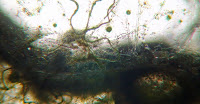Fox, Richard. "Inervetebrate Anatomy Online." Philodina Rotifer. 2001. Lander University, Web. 11 Nov 2009. http://webs.lander.edu/rsfox/inervetebrates/philodina.html.
Integrative and Comparative Biology 2002 42(3):660-667; doi:10.1093/icb/42.3.660
2002 by the society for Integrative and Comparative Biology.
http://icb.oxfordjournals.org/cgi/content.tull/42/3/660
Pennack, Robert. Fresh Water Invertebrates of the United States. 3rd.
Wiley-Interscience Publication, 203-207. Print.
Segers, H. (2009) Philodina Roseola Ehrenberg, 1832. In: Segers, H. )Ed.) (2009). World Rotifera database from FADA. Accessed through: World Register of Marine Species at
http://www.marinespecies.org/aphia.php?p=taxdetails&id=247966 on 2009-11-11
Tuesday, November 10, 2009
Week Five




This week things seem to look pretty much the same as last week the same rotifers were seen moving around eating particles. There seemed to be a few more single celled organisms seen moving about. The video above of the Philodina Rotifer shows the Rotifer eating things and then i tapped on the stage and the Rotifer immediately callapsed and then after a few seconds came back up. The picture about of the organism is a Lacaeing Rotifer it moves quickly around the aquarium and it was extremely hard to get a good picture of eating or actually in motion. There is a picture above of the trap that i talked about in my blog last week. The aquarium has shown significant growth over the past five weeks and will continue to grow and more organisms will probably start to show up.
Sunday, November 8, 2009
Week Four
While observing my microaquarium this week a few more organisams were identified. There was a lacae Rotifer and it was moving around quickly eating small particles. A Halteria was identified spinning around in circles. A Haltaria is a small organism that is hard to see there were many of them all over the aquarium. A trap was identified in the plants, the trap catches things and they die in the trap and then parameciums consume the decaying debris. Also a Philodina Rotifer was identified on a plant i took a video of it but at the moment it will not load i will post it next week. The Philodina Rotifer was extremely interesting to obsesrve it would calapse when i tapped on the stage. My microaquarium is growing and flourishing week by week i will post more next week.
Thursday, October 29, 2009
Week Three
During the examination of my micro aquarium today i discovered a few new things. I began to notice a few larger organisms that were swimming around pretty fast. I later identified them as Rotifers which are shaped sort of wheel-like wiht hairy appendages, free swimming or attached. These Rotifers are transparent and hard to notice at first. The smaller single celled organisms were still present and swimming in their same circulor pattern, there seemed to be even more of them than last week. I also think that there may have been a few ciliates, I will have to further investigate them next week. Finishing up my observations i realized the water was low so i added some more water before returning my aquarium to the light.
Wednesday, October 21, 2009
Week Two
While examining the micro aquarium today there were many more organisms present. There were more single celled organisms swimming around in the same circular manor. This week i noticed larger single celled organisms,that are unidentified as of now, but they swam straight and really fast through the plants they did not seem to make their way into the open water. I added one beta food pellet, "Atison's Betta Food" is made by Ocean Nutrition, Aqua Pet Americas, 3528 West 500 South, Salt Lake City, UT 84104. Ingredients: Fish meal, wheat flower, soy meal, krill meal, minerals, vitamins and preservatives. Analysis: Crude Protein 36%; Crude fat 4.5%; Crude Fiber 3.5%; Moisture 8% and Ash 15%. Next week i hope to be able to identify the organisms and observe more growth.
Sunday, October 18, 2009
Week One
We built our micro aquariums in class this past week. Water from mixture 4 was placed inside and then a piece of plants A and B, and also sediments from the bottom of the water mixture. Water number for came from the Holston River along John Sevier Hwy. Plant A is an Amblystegium varium Moss. Collection from: Natural spring, located at Carters Mill Park. Plant B is a carnivous plant, from south shore of Spain Lake. There were several single celled organisms seen near the plants and close to the bottom where the sediments were located. These organisms spinning around in a circular manor. No organisms were seen in the empty areas and they would not have been noticed around the plants if they would not have been moving. I will be observing the changed of the plants and organisms in my micro aquarium and blogging each week.
Subscribe to:
Comments (Atom)

